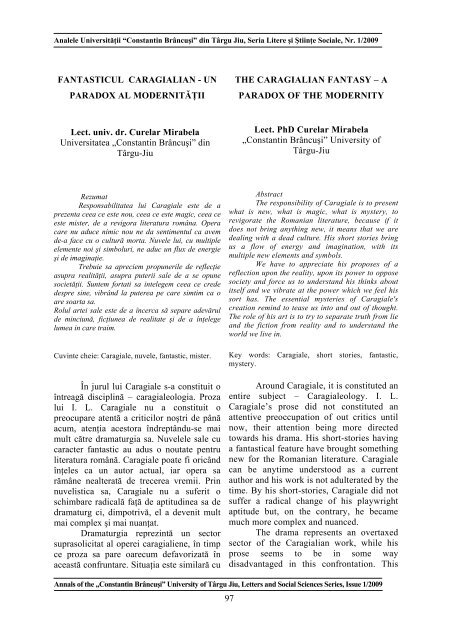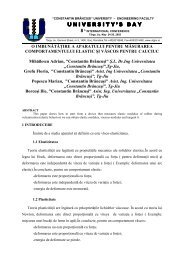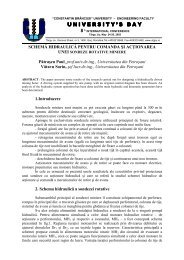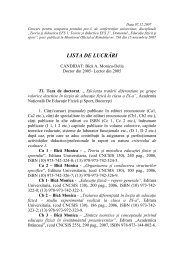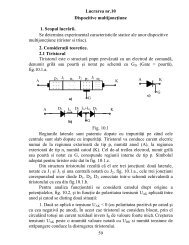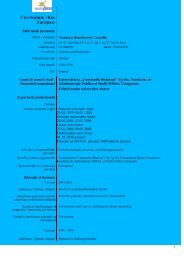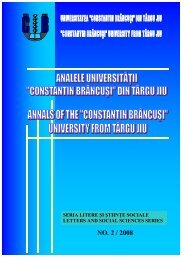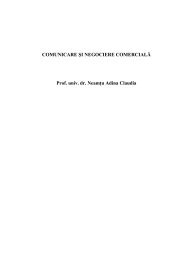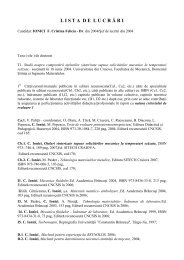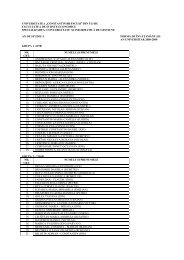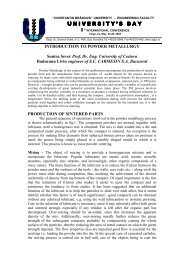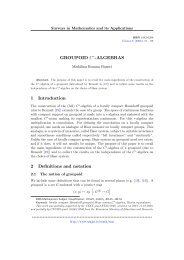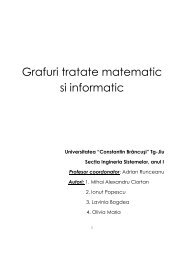UN PARADOX AL MODERNITĂŢII Lect. univ. dr. Curelar Mirabela ...
UN PARADOX AL MODERNITĂŢII Lect. univ. dr. Curelar Mirabela ...
UN PARADOX AL MODERNITĂŢII Lect. univ. dr. Curelar Mirabela ...
You also want an ePaper? Increase the reach of your titles
YUMPU automatically turns print PDFs into web optimized ePapers that Google loves.
Analele Universităţii “Constantin Brâncuşi” din Târgu Jiu, Seria Litere şi Ştiinţe Sociale, Nr. 1/2009<br />
FANTASTICUL CARAGI<strong>AL</strong>IAN - <strong>UN</strong><br />
<strong>PARADOX</strong> <strong>AL</strong> <strong>MODERNITĂŢII</strong><br />
<strong>Lect</strong>. <strong>univ</strong>. <strong>dr</strong>. <strong>Curelar</strong> <strong>Mirabela</strong><br />
Universitatea „Constantin Brâncuşi” din<br />
Târgu-Jiu<br />
Rezumat<br />
Responsabilitatea lui Caragiale este de a<br />
prezenta ceea ce este nou, ceea ce este magic, ceea ce<br />
este mister, de a revigora literatura româna. Opera<br />
care nu aduce nimic nou ne da sentimentul ca avem<br />
de-a face cu o cultură morta. Nuvele lui, cu multiple<br />
elemente noi şi simboluri, ne aduc un flux de energie<br />
şi de imaginaţie.<br />
Trebuie sa apreciem propunerile de reflecţie<br />
asupra realităţii, asupra puterii sale de a se opune<br />
societăţii. Suntem fortati sa intelegem ceea ce crede<br />
despre sine, vibrând la puterea pe care simtim ca o<br />
are soarta sa.<br />
Rolul artei sale este de a încerca să separe adevărul<br />
de minciună, ficţiunea de realitate şi de a înţelege<br />
lumea in care traim.<br />
Cuvinte cheie: Caragiale, nuvele, fantastic, mister.<br />
În jurul lui Caragiale s-a constituit o<br />
întreagă disciplină – caragialeologia. Proza<br />
lui I. L. Caragiale nu a constituit o<br />
preocupare atentă a criticilor noştri de până<br />
acum, atenţia acestora în<strong>dr</strong>eptându-se mai<br />
mult către <strong>dr</strong>amaturgia sa. Nuvelele sale cu<br />
caracter fantastic au adus o noutate pentru<br />
literatura română. Caragiale poate fi oricând<br />
înţeles ca un autor actual, iar opera sa<br />
rămâne nealterată de trecerea vremii. Prin<br />
nuvelistica sa, Caragiale nu a suferit o<br />
schimbare radicală faţă de aptitudinea sa de<br />
<strong>dr</strong>amaturg ci, dimpotrivă, el a devenit mult<br />
mai complex şi mai nuanţat.<br />
Dramaturgia reprezintă un sector<br />
suprasolicitat al operei caragialiene, în timp<br />
ce proza sa pare oarecum defavorizată în<br />
această confruntare. Situaţia este similară cu<br />
Annals of the „Constantin Brâncuşi” University of Târgu Jiu, Letters and Social Sciences Series, Issue 1/2009<br />
97<br />
THE CARAGI<strong>AL</strong>IAN FANTASY – A<br />
<strong>PARADOX</strong> OF THE MODERNITY<br />
<strong>Lect</strong>. PhD <strong>Curelar</strong> <strong>Mirabela</strong><br />
„Constantin Brâncuşi” University of<br />
Târgu-Jiu<br />
Abstract<br />
The responsibility of Caragiale is to present<br />
what is new, what is magic, what is mystery, to<br />
revigorate the Romanian literature, because if it<br />
does not bring anything new, it means that we are<br />
dealing with a dead culture. His short stories bring<br />
us a flow of energy and imagination, with its<br />
multiple new elements and symbols.<br />
We have to appreciate his proposes of a<br />
reflection upon the reality, upon its power to oppose<br />
society and force us to understand his thinks about<br />
itself and we vibrate at the power which we feel his<br />
sort has. The essential mysteries of Caragiale′s<br />
creation remind to tease us into and out of thought.<br />
The role of his art is to try to separate truth from lie<br />
and the fiction from reality and to understand the<br />
world we live in.<br />
Key words: Caragiale, short stories, fantastic,<br />
mystery.<br />
Around Caragiale, it is constituted an<br />
entire subject – Caragialeology. I. L.<br />
Caragiale’s prose did not constituted an<br />
attentive preoccupation of out critics until<br />
now, their attention being more directed<br />
towards his <strong>dr</strong>ama. His short-stories having<br />
a fantastical feature have brought something<br />
new for the Romanian literature. Caragiale<br />
can be anytime understood as a current<br />
author and his work is not adulterated by the<br />
time. By his short-stories, Caragiale did not<br />
suffer a radical change of his playwright<br />
aptitude but, on the contrary, he became<br />
much more complex and nuanced.<br />
The <strong>dr</strong>ama represents an overtaxed<br />
sector of the Caragialian work, while his<br />
prose seems to be in some way<br />
disadvantaged in this confrontation. This
Analele Universităţii “Constantin Brâncuşi” din Târgu Jiu, Seria Litere şi Ştiinţe Sociale, Nr. 1/2009<br />
cea a lui Eminescu. Prozatorul a fost<br />
întotdeauna pus în umbră de poet, dar şi<br />
într-un caz şi în celălalt, echilibrul trebuie să<br />
fie restabilit. Cu amândoi marii noştri clasici<br />
s-a produs acelaşi lucru: o limitare, o<br />
reducţie ce ţine de estetica receptării.<br />
Prozatorul nu este cu nimic mai prejos decât<br />
<strong>dr</strong>amaturgul.<br />
În nuvelistică, Ion Luca Caragiale<br />
este mai autentic, mai viu, mai actual decât<br />
oriunde în creaţia sa, el rămânând unul<br />
dintre cei mai mari nuvelişti ai noştri, din<br />
toate timpurile. În nuvelistica sa putem<br />
distinge două direcţii distincte: una analitică<br />
şi alta fantastică. Şi în nuvelistică s-a<br />
acordat mai mult credit direcţiei analitice.<br />
Nuvelele O făclie de Paşte, În vreme de<br />
război şi Două loturi au polarizat mai mult<br />
atenţia cercetătorilor decât nuvelele sale<br />
fantastice: La hanul lui Mânjoală, Kir<br />
Ianulea, Abu-Hasan, Pastramă trufanda,<br />
Calul <strong>dr</strong>acului. Textul nuvelelor fantastice<br />
caragialiene se impune prin aspecte de mare<br />
interes istoric şi literar. În cuprinsul lor am<br />
sesizat motive şi teme cu totul noi pentru<br />
proza autohtonă , care merită examinate cu<br />
mare atenţie.<br />
Am observat la Caragiale o<br />
preocupare pentru problemele umane,<br />
pentru aspectul lor dificil şi în<strong>dr</strong>ăzneala sa<br />
de a le fi atacat fără inutile sau ipocrite<br />
ocolişuri. Caragiale s-a simţit atras de<br />
pornirile sufleteşti obscure, de fiinţe<br />
paradoxale, de regulile destinului, de situaţii<br />
enigmatice, de magie şi ambiguitate; el a<br />
proiectat, în prim plan, zone de umbră,<br />
dezvoltând, astfel, un fantastic straniu,<br />
terifiant, foarte apropiat de fantasticul lui<br />
Edgar Allan Poe. Dar nuvelele lui Caragiale<br />
sunt alimentate şi din credinţe şi superstiţii<br />
populare, cultivând astfel un fantastic de<br />
sorginte folclorică, iar anecdotele sale<br />
cultivă un fantastic anecdotic.<br />
Am urmărit latura umană, artistică,<br />
satirică şi fantastică a lui Caragiale, prin<br />
intermediul categoriilor estetice precum:<br />
comicul, tragicul, clasicismul, romantismul,<br />
realismul, naturalismul, manierismul şi<br />
situation is similar to Eminescu’s situation.<br />
The prose writer was always crossed by the<br />
poet, but, in both of the cases, the poise<br />
must be reestablished. With both of our<br />
great classics it is produced the same thing:<br />
a limitation, a reduction related to the<br />
interception’s aesthetics. The prose writer is<br />
as great as the playwright.<br />
Regarding the short-stories, Ion Luca<br />
Caragiale is more authentic, more alive,<br />
more current than anywhere in his creation,<br />
remaining one of our greatest short-story<br />
writers of all the times. In his short-stories,<br />
we can distinguish two different directions:<br />
an analytical one and a fantastical one. In<br />
the short-stories, it was granted more credit<br />
to the analytical direction. The short-stories<br />
named A Flame for Easter, War Time, and<br />
Two Tickets polarized more the attention of<br />
the researchers than his fantastical shortstories:<br />
Mânjoală’s Inn, Kir Ianulea, Abu-<br />
Hasan, Hasting Salt Meat, Devil’s Horse.<br />
The Caragialian fantastical short-stories’<br />
text imposes by aspects having great<br />
historical and literal interest. In their<br />
content, we have noticed motifs and themes<br />
entirely new for the autochthonous prose,<br />
that deserve to be attentively examined.<br />
We noticed at Caragiale a concern<br />
for the human problems, for their difficult<br />
aspect and his dare to attack them directly.<br />
Caragiale was attracted by the obscure soul<br />
impulses, by paradoxical beings, by the<br />
destiny’s rules, by the enigmatical<br />
situations, by magic and ambiguity; he<br />
projected mainly dark areas, developing<br />
thus a strange, terrifying fantasy placed very<br />
close of Edgar Poe’s fantasy. But<br />
Caragiale’s short-stories are also supplied<br />
by popular beliefs and superstitions,<br />
developing thus a folkloric fantasy and his<br />
anecdotes develop an anecdotic fantasy.<br />
We followed the human, artistic,<br />
satirical and fantastical side of Caragiale, by<br />
means of the aesthetical categories as: the<br />
comicality, the tragic aspect, the classicism,<br />
the romanticism, the realism, the naturalism,<br />
the mannerism and the fantasticality.<br />
Annals of the „Constantin Brâncuşi” University of Târgu Jiu, Letters and Social Sciences Series, Issue 1/2009<br />
98
Analele Universităţii “Constantin Brâncuşi” din Târgu Jiu, Seria Litere şi Ştiinţe Sociale, Nr. 1/2009<br />
fantasticul. Cariera literară a lui Caragiale<br />
este dificilă încă de la început deoarece el<br />
pare să ignore consensul şi renumele epocii<br />
sale, el îşi creează propriile reguli de joc,<br />
inedite, asumându-şi riscul de a rămâne<br />
uneori neînţeles.<br />
Caragiale se apropie uneori de zonele<br />
cele mai umbrite ale unei psihologii (O<br />
făclie de Paşte, În vreme de război), iar<br />
alteori depăşeşte hotarele fabulosului, cu un<br />
surâs ambiguu (La hanul lui Mânjoală, Kir<br />
Ianulea, Calul <strong>dr</strong>acului), întotdeauna<br />
sugerând cel puţin una din cauzele<br />
misterului, dar refuzând să-l accepte până la<br />
urmă ca atare.<br />
Caragiale produce cazuri de<br />
sminteală, triste sau vesele, pozitive sau<br />
negative, comice sau stupide, dar nebunia<br />
evocată de Caragiale în nuvelele sale nu<br />
intră obligatoriu în intenţia sa, el fiind mai<br />
puţin un analist ocazional de maladii<br />
ereditare şi mai mult un observator de<br />
moravuri. Nebunia personajelor sale<br />
dezvoltă un amestec de luciditate şi<br />
iraţional, de nesfârşit delir, o imprevizibilă<br />
stare din care se poate genera adevărul sau<br />
fantazarea.<br />
Fantasticul este o direcţie<br />
fundamentală a literaturii şi chiar un revers<br />
al realismului. Caragiale este unul dintre cei<br />
mai mari creatori ai absurdului din literatura<br />
română. Şi pentru ca această poetică a<br />
contrastelor să fie şi mai completă,<br />
Caragiale ne-a oferit un pandant la filonul<br />
realist al operei sale, prin fantastic,<br />
componentă însemnată a operei<br />
caragialiene, vizibilă mai ales în nuvelistică.<br />
Există o apropiere evidentă între<br />
fantasticul caragialian şi fantasticul lui<br />
Edgar Allan Poe, fantastic ce a constituit un<br />
real model pentru proza lui Caragiale. Prin<br />
Nerval şi Poe, tensiunea fantastică redevine<br />
teroare sau realitate obscură a personalităţii<br />
creatoare, motiv preluat şi de Ion Luca<br />
Caragiale. Tocmai de aceea am afirmat că<br />
fantasticul caragialian se apropie tot mai<br />
mult de fantasticul poesc. Şi Caragiale<br />
creează acest fantastic cerebral, chiar<br />
Caragiale’s literary career is difficult from<br />
the beginning because he seems to ignore<br />
the consensus and the renown of his age, he<br />
creates his own new game rules, assuming<br />
the risk to remain sometimes<br />
incomprehensible.<br />
Caragiale sometimes approaches the<br />
darkest areas of a certain psychology (A<br />
Flame for Easter, War time) and other<br />
times, he crosses the limits of the fabulous,<br />
with an ambiguous smile (Mânjoală’s Inn,<br />
Kir Ianulea, Devil’s Horse), always<br />
suggesting at least of the mystery’s causes,<br />
but finally refusing to accept it as such.<br />
Caragiale produces crazy cases, sad<br />
or happy ones, positive or negative ones,<br />
comical or stupid ones, but the madness<br />
evoked by Caragiale in his short-stories<br />
does not enter in a compulsory way in his<br />
intention because he is rather a morals<br />
observer than an occasional analyst of<br />
hereditary diseases. His characters’ folly<br />
develops a mix of lucidity and unreasonable<br />
aspect, of permanent delirium, of an<br />
unpredictable situation from which it can be<br />
generated the truth or the fantasy.<br />
The fantasy is a fundamental<br />
direction of the literature and even a reverse<br />
of the realism. Caragiale is one of the<br />
greatest creators of the absurdity in the<br />
Romanian literature. For that the poetics of<br />
contrasts to be even more complete,<br />
Caragiale offered us a counterpart to the<br />
realist lode of his work, by the fantasy, an<br />
important component of the Caragialian<br />
work, visible especially in the short-stories.<br />
There is an obvious approach<br />
between the Caragialian fantasy and Edgar<br />
Allan Poe’s fantasy, a fantasy that<br />
constituted a real model for Caragiale’s<br />
prose. By Nerval and Poe, the fantastical<br />
tension becomes again a terror or an obscure<br />
reality of the creating personality, a motif<br />
also taken over by Ion Luca Caragiale. That<br />
is why we affirmed that the Caragialian<br />
fantasy is closer of the Poescian fantasy.<br />
Caragiale creates this cerebral fantasy too,<br />
even a paradoxically direct fantasy that goes<br />
Annals of the „Constantin Brâncuşi” University of Târgu Jiu, Letters and Social Sciences Series, Issue 1/2009<br />
99
Analele Universităţii “Constantin Brâncuşi” din Târgu Jiu, Seria Litere şi Ştiinţe Sociale, Nr. 1/2009<br />
paradoxal de direct, care merge până la<br />
limita terifiantului şi absurdului.<br />
Putem susţine ideea unicităţii<br />
fantasticului caragialian, care, spre<br />
deosebire de fantasticul lui Eminescu sau<br />
Creangă, este saturat de magie şi<br />
ambiguitate. La Caragiale, legile<br />
supranaturalului se hrănesc din superstiţii<br />
populare sau din legende, iar existenţa<br />
umană, în deplină convieţuire cu personajele<br />
malefice, apare doar ca o uşoară ciudăţenie,<br />
explicabilă raţional. Această pendulare<br />
comico-tragică între real şi fantastic, conferă<br />
prozei caragialiene o savoare şi o<br />
autenticitate românească. Dacă la Eminescu<br />
sau Creangă fantasticul este firav, estetic,<br />
cosmetizat, presărat de frumuseţe şi reţinere,<br />
precum în basmele cu zâne şi feţi frumoşi, la<br />
Caragiale fantasticul este situat la polul<br />
opus, fiind aglomerat de personaje malefice,<br />
duhuri diavoleşti, practici vrăjitoreşti şi<br />
superstiţii populare care pot schimba<br />
destinele oamenilor. Chiar şi personajele<br />
feminine, care, prin natura lor umană ar fi<br />
constituit frumuseţea şi fragilitatea, la<br />
Caragiale, femeia uzează de o virtuozitate<br />
demonologică, frumuseţea sa fiind un atu al<br />
puterii diavoleşti şi nu al fragilităţii<br />
angelice. În nuvelele lui Caragiale, bărbatul<br />
este cel firav, supus, întotdeauna situat în<br />
inferioritatea femeii, chiar şi atunci când el<br />
este însuşi diavolul (Kir Ianulea).<br />
Critica literara a stabilit o<br />
corespondenţă între <strong>dr</strong>amaturgia lui<br />
Caragiale şi proza sa scurtă, urmărind<br />
<strong>univ</strong>ersul Momentelor şi schiţelor. Revanşa<br />
prozatorului vine în completarea<br />
<strong>dr</strong>amaturgiei sale. Întreaga operă a lui<br />
Caragiale este, simultan, un semn al realului<br />
dar şi o acceptare, prin ironie, a complexului<br />
fantastic, în care autorul este tentat să<br />
evadeze.<br />
Miticismul lui Caragiale dezvoltă<br />
esenţe, subliniază iluzoriul şi convenţionalul<br />
unei lumi reale, dar îşi propune totodată o<br />
aerisire în plan spiritual, căci personajul îşi<br />
aplică uneori o etichetă de ilar şi tembel,<br />
care îi reduce imaginea realistă. El poate fi<br />
to the limit of the terrifying aspect and the<br />
absurdity.<br />
We may maintain the oneness idea of<br />
the Caragialian fantasy that, unlike<br />
Eminescu’s or Creangă’s fantasy, is<br />
saturated by magic and ambiguity. At<br />
Caragiale, the supernatural’s rules are<br />
supplied by popular superstitions or legends<br />
and the human existence, living together<br />
with the malefic characters, appears only as<br />
a slight, reasonably explicable oddity. This<br />
comical-tragic vacillation between reality<br />
and fantasy offers the Caragialian prose a<br />
Romanian taste and authenticity. If, at<br />
Eminescu or Creangă, the fantasy is fragile,<br />
aesthetic, covered, surrounded by beauty<br />
and restraint, like in the tales with princes<br />
and fairies, at Caragiale, the fantasy is<br />
placed at the opposite pole, being crowded<br />
by malefic characters, devilish spirits,<br />
witches’ practices and popular superstitions<br />
that can change the humans’ destinies. Even<br />
the feminine characters that, by their human<br />
nature would constitute beauty and fragility,<br />
at Caragiale, the woman uses a devilish<br />
virtuosity, her beauty being an advantage of<br />
the devilish power and not of the angelic<br />
fragility. In Caragiale’s short-stories, the<br />
man is the fragile one, the obedient one,<br />
always placed in the woman’s inferiority,<br />
even when he is the devil himself.<br />
The literary critique established a<br />
correspondence between Caragiale’s <strong>dr</strong>ama<br />
and his short prose, following the <strong>univ</strong>erse<br />
of the Moments and Sketches. The prose<br />
writer’s revenge completes his <strong>dr</strong>ama.<br />
Caragiale’s entire work is simultaneously a<br />
sign of the realism but also an ironical<br />
acceptation of the fantastical complex where<br />
the author is tempted to escape.<br />
Caragiale’s mythical aspect develops<br />
essences, emphasizes the illusory and<br />
conventional aspect of a real world, but in<br />
the same time it wants a spiritual<br />
refreshment because the character is<br />
sometimes hilarious and stupid, fact that<br />
reduces its realist image. It can be used also<br />
in the fantastical stories where the<br />
Annals of the „Constantin Brâncuşi” University of Târgu Jiu, Letters and Social Sciences Series, Issue 1/2009<br />
100
Analele Universităţii “Constantin Brâncuşi” din Târgu Jiu, Seria Litere şi Ştiinţe Sociale, Nr. 1/2009<br />
utilizat şi în poveştile fantastice, în care<br />
personajele nu mai sunt conduse de propria<br />
raţiune, ci de o forţă care le dictează<br />
destinul. Printr-o abatere norocoasă de la<br />
viziunea lui satirică, Caragiale a reuşit să se<br />
în<strong>dr</strong>epte, prin nuvelele sale, către un<br />
fantastic modern, lăsând impresia unui autor<br />
deosebit de flexibil şi relaxat.<br />
Nuvelistica lui Ion Luca Caragiale<br />
urmăreşte trei coordonate esenţiale pentru<br />
fantasticul caragialian: Fantasticul de<br />
sorginte folclorică - Ion Luca Caragiale şi<br />
basmul cult, Fantasticul straniului şi<br />
terifiantului – Influenţa lui Edgar Allan Poe,<br />
Fantasticul anecdotic – Atmosferă balcanică<br />
şi fabulos oriental Este uşor de înţeles<br />
acum fantasticul lui Caragiale, care îşi are<br />
sorgintea în folclor; el se bazează pe<br />
superstiţii şi legende populare. Caragiale<br />
poate fi considerat un urmaş al lui Ianus<br />
Bifrons, personaj care a făcut carieră în<br />
mitologia greacă arătându-ne cum cu o faţă<br />
râde, la fel ca şi comicul Caragiale, iar cu<br />
cealaltă plânge, apropiindu-se astfel de<br />
latura tragicului caragialian.<br />
Basmul este generat de prezenţa unor<br />
întâmplări stranii sau fiinţe himerice<br />
înzestrate cu puteri supraomeneşti, de<br />
obiecte cu virtuţi magice şi de unele acţiuni<br />
specifice, precum metamorfoza şi<br />
proteismul. Basmul este însă oarecum<br />
superior mitologiei şi presupune o artă<br />
rafinată. . In legende, în balade, în eposul<br />
popular, în general în mitologie, fantasticul<br />
se manifestă de la sine. Miracolul devine<br />
firesc şi, odată instalat în fantastic, cititorul<br />
nu mai este surprins, nu se mai înspăimântă,<br />
minunile devin posibile, tensiunile sunt<br />
eliminate. Caragiale ne invita să participăm<br />
la un fantastic straniu, absurd, în<strong>dr</strong>ăzneţ,<br />
lipsit de cosmetizări , potrivit epocii<br />
contemporane.<br />
Am descoperit că fantasticul<br />
straniului şi terifiantului presupune<br />
întâmplări care fac parte din sfera realităţii,<br />
dar sunt cu totul neobişnuite, ciudate,<br />
singulare, ieşite din comun, care trezesc în<br />
noi sentimente de nelinişte, spaimă,<br />
characters are not leaded by their own<br />
reason any more, but by a force that<br />
establishes their destiny. By a lucky<br />
deviation from his satirical vision, Caragiale<br />
managed to go, by his short-stories, towards<br />
a modern fantasy, leaving the impression of<br />
an extremely flexible and relaxed author.<br />
Ion Luca Caragiale’s short-stories<br />
follow three coordinates essential for the<br />
Caragialian fantasy: the folkloric fantasy –<br />
Ion Luca Caragiale and cultured tale, the<br />
strange and terrifying fantasy – influence of<br />
Edgar Allan Poe, the anecdotic fantasy –<br />
Balkan atmosphere and oriental fabulous<br />
aspect. It is now easy to understand<br />
Caragiale’s fantasy that has its origin in the<br />
folklore; it is based on popular superstitions<br />
and legends. Caragiale may be considered a<br />
successor of Ianus Bisfrons, a character that<br />
had a career in the Greek mythology,<br />
showing us how he could laugh with one<br />
face, like the comical Caragiale, and how he<br />
could cry with the other one, being thus<br />
closer of the Caragialian tragic aspect’s<br />
side.<br />
The tale is generated by the presence<br />
of certain strange situations or chimaeric<br />
beings having superhuman powers, by<br />
objects having magical qualities and by<br />
certain specific actions, like metamorphose<br />
and protheism. But the tale is superior to<br />
the mythology and it supposes a<br />
sophisticated art. In legends, in ballads, in<br />
the popular saga, generally in mythology,<br />
the fantasy manifests from itself. The<br />
miracle becomes natural and, as soon as it is<br />
installed in the fantasy, the reader is not<br />
surprised or scared any more, the wonders<br />
become possible and the pressures are<br />
eliminated. Caragiale invited us to<br />
participate to a strange, absurd, daring,<br />
uncovered fantasy appropriate to the<br />
contemporary age.<br />
We have discovered that the strange<br />
and terrifying fantasy supposes situations<br />
that are part of the reality’s sphere, but there<br />
are entirely unusual, bizarre, singular,<br />
different, that provoke us feelings of<br />
Annals of the „Constantin Brâncuşi” University of Târgu Jiu, Letters and Social Sciences Series, Issue 1/2009<br />
101
Analele Universităţii “Constantin Brâncuşi” din Târgu Jiu, Seria Litere şi Ştiinţe Sociale, Nr. 1/2009<br />
perplexitate, groază, teroare. Coincidenţele<br />
stranii şi terifiante sunt uneori opera<br />
întâmplării sau rezultatul unei fatalităţi<br />
obscure.<br />
Caragiale a cercetat maniera<br />
fantastică a lui Edgar Allan Poe, capacitatea<br />
sa de a crea o atmosferă terifiantă, prin<br />
tehnica întreţinerii misterului, a tainei, a<br />
enigmei, motive întâlnite şi la Caragiale.<br />
Capodopera sa, Prăbuşirea casei Usher, ne<br />
introduce într-o atmosferă stranie, în care<br />
eroul este marcat de degenerescenţă şi<br />
anxietate, este bolnav de spaimă, stăpânit de<br />
groază, marcat de teroare, psihotic chiar,<br />
stare pusă de către autor în relaţie directă şi<br />
ocultă, cu vechimea şi şubrezenia clădirii,<br />
umezeala zidurilor, menţinând ambianţa de<br />
teroare a locurilor, cu elemente<br />
producătoare de coşmar.<br />
Dacă la Edgar Allan Poe descinderea<br />
în extraordinar şi straniu este o experienţă<br />
de tip gotic, urmărind să producă o surpriză<br />
înfricoşătoare, la Caragiale aventura îşi<br />
pierde stabilitatea, impunându-se o<br />
suprapunere între normal şi supranatural.<br />
Aceste accesorii parafantastice ţin să creeze<br />
ambianţa ororii în opera lui Caragiale.<br />
Finalul capodoperei caragialiene La hanul<br />
lui Mânjoală, prin arderea din temelii a<br />
hanului, pare un fel de prăbuşire a casei<br />
Usher. Ceea ce ne sugerează Caragiale este<br />
groaza, teroarea interioară şi psihică a<br />
personajelor. La Caragiale nu percepem<br />
simţământul groazei şi al remuşcării unui<br />
om care a ucis, ci groaza de a nu fi el ucis,<br />
frica de moarte.<br />
Taina din nuvela La hanul lui<br />
Mânjoală este dezlegată prin implicarea<br />
subiectului în realitate, starea de<br />
incertitudine, enigmele, notaţiile sufleteşti<br />
fiind relatate sub forma unor întâmplări<br />
posibile, obişnuite, chiar fireşti. Opera lui<br />
Caragiale are un substrat folcloric, în care<br />
fantasticul este plăsmuit în real, într-un<br />
decor deosebit de sugestiv, propriu<br />
întâmplărilor stranii şi practicilor magice ale<br />
hangiţei asupra călătorului sosit la han. În<br />
nuvela de faţă, „echivocul planurilor,<br />
anxiety, fright, perplexity, horror, terror.<br />
The strange and terrifying coincidences are<br />
sometimes the work of the occurrence or the<br />
result of an obscure fatum.<br />
Caragiale researched Edgar Allan<br />
Poe’s fantastical manner, his ability to<br />
create a terrifying atmosphere, by the<br />
technique of maintaining the mystery, the<br />
secret, the enigma, motifs that we also find<br />
at Caragiale. His masterpiece, Usher<br />
House’s Crush, introduces us into a strange<br />
atmosphere where the hero is marked by the<br />
degeneration and the anxiety, is sick of<br />
fright, governed by the horror, marked by<br />
the terror, even psychotic, a situation put by<br />
the author in a direct and obscure relation<br />
with the building’s antiquity and frailty, the<br />
wall’s humidity, maintaining the terror<br />
ambiance of the places, with elements that<br />
produce nightmares.<br />
If, at Edgar Allan Poe, the descent in<br />
the extraordinary and strange aspect is a<br />
gothic experience, following to produce a<br />
frightening surprise, at Caragiale, the<br />
adventure loses its stability, imposing a<br />
superposition between the normal and the<br />
supernatural aspect. These para-fantastical<br />
accessories want to create the horror<br />
ambiance in Caragiale’s work. The end of<br />
Mânjoală’ s Inn Caragialian masterpiece, by<br />
burning the inn, seems to be some kind of<br />
crush of the Usher house. Caragiale<br />
suggests us the horror, the characters’<br />
internal and mental terror. At Caragiale, we<br />
do not perceive the feeling of horror and<br />
compunction of a man who killed, but the<br />
horror of not being killed, the fright of<br />
death.<br />
The secret from the Mânjoală’s Inn<br />
short-story is solved by involving the<br />
subject in the reality, the insecurity, the<br />
enigmas, the soul notations being described<br />
as possible, usual, even natural situations.<br />
Caragiale’s work has a folkloric substratum<br />
where the fantasy is built in reality, in an<br />
extremely suggestive background,<br />
appropriate to the strange situations and<br />
magical practices of the landlady on the<br />
Annals of the „Constantin Brâncuşi” University of Târgu Jiu, Letters and Social Sciences Series, Issue 1/2009<br />
102
Analele Universităţii “Constantin Brâncuşi” din Târgu Jiu, Seria Litere şi Ştiinţe Sociale, Nr. 1/2009<br />
aşezarea diavolului în calea flăcăului<br />
simbolizează ignoranţa adolescenţei despre<br />
propriile ei imbolduri”.<br />
Misterul cultivat în povestirea<br />
caragialiană este emanaţia farmecului<br />
feminin, degajat de stăpâna hanului, factor<br />
real de contaminare a oaspeţilor.<br />
Originalitatea viziunii fantastice din La<br />
hanul lui Mânjoală îşi are sursa în<br />
extraordinarele efecte produse de impactul<br />
dintre cele două moduri de înţelegere şi<br />
explorare a noţiunii de mister. Aceeaşi<br />
atmosferă o întâlnim şi în povestirea La<br />
conac, unde lucrurile se petrec, parcă, sub<br />
influenţa unei hipnoze.<br />
Ambele texte, La hanul lui Mânjoală<br />
şi La conac sunt ambigue, în interpretarea<br />
lor, <strong>dr</strong>umul căpătând un sens general<br />
iniţiatic (ca în Povestea lui Harap-Alb) sau<br />
un sens fantastic, deoarece întâmplările la<br />
care sunt supuşi eroii ar putea să fi regizate<br />
şi dirijate de forţele Infernului, aflate mai<br />
presus de puterea omenească de înţelegere.<br />
Tocmai pe această dialectică a duplicităţii<br />
de semnificaţii se bazează literatura<br />
fantastică.<br />
Kir Ianulea aminteşte de nuvela<br />
Belfegor arccidiavolo, a lui Machiavelli şi<br />
evocă o atmosferă de început de secol al<br />
unui Bucureşti fanariot, pitoresc, degajând o<br />
ciudată şi tulburătoare anecdotă. Această<br />
nuvelă particularizează fantasticul<br />
miniaturizat prin comic cu un motiv mai<br />
vechi – <strong>dr</strong>acul păcălit de femeie şi apelul la<br />
evocarea istorică. Trecerea de la un plan la<br />
altul este imperceptibilă.<br />
Motivul este cel al femeii mai rele<br />
decât <strong>dr</strong>acul. Elementele romantice se<br />
împletesc cu fantasticitatea sugerând o<br />
realitate îndepărtată în timp, în care Acriviţa<br />
este o femeie cu puteri magice, iar Aghiuţă,<br />
travestit în chipul bunului negustor Kir<br />
Ianulea, are rol de „simplu experimentator<br />
care să verifice plângerile tuturor răposaţilor<br />
ajunşi în iad de pe urma soţiilor”. Dar<br />
diavolul nu ia nici o iniţiativă, fiind dispus<br />
să îndure atât toanele, cât şi egoismul<br />
femeii.<br />
traveler arrived at the inn. In the current<br />
short-story, “the plans’ ambiguity, the devil<br />
placed in the boy’s way, all of these means<br />
the ignorance of the adolescence about its<br />
own impulses”.<br />
The mystery developed in the<br />
Caragialian story is the emanation of the<br />
feminine charm, emitted by the landlady, a<br />
real factor of contamination of the guests.<br />
The fantastical vision’s originality from<br />
Mânjoală’s Inn has its source in the<br />
extraordinary effects produced by the<br />
impact between the two ways of<br />
understanding and exploring the mystery<br />
notion. We find the same atmosphere in the<br />
story At the Mansion, where it seems that<br />
the things happen under the influence of<br />
hypnosis.<br />
Both of the texts, Mânjoală’s Inn<br />
and At the Mansion are ambiguous, in their<br />
interpretation, the road getting a general<br />
initiatory sense (like in Harap-Alb’s Story)<br />
or a fantastical sense because to situations<br />
of the heroes could be directed and leaded<br />
by the Hell’s forces, placed beyond the<br />
human understanding power. The fantastical<br />
literature is based on this dialectics of<br />
significations duplicity.<br />
Kir Ianulea remembers us of<br />
Belfegor arccidiavolo short-story of<br />
Machiavelli and evokes an atmosphere of<br />
beginning of a century of a Phanariot,<br />
picturesque Bucharest, emitting a strange<br />
and troubling anecdote. This short-story<br />
particularizes the fantasy miniaturized by<br />
the comical feature with an old motif – the<br />
devil hoaxed by the woman and the appeal<br />
to the historical evocation. The passing<br />
from a plan to another is imperceptible.<br />
The motif is that the woman is worse<br />
than the devil. The romantic elements are<br />
combined with the fantasy, suggesting a<br />
reality estranged in time, where Acriviţa is a<br />
woman with magical powers and Aghiuţă,<br />
disguised as the good merchant Kir Ianulea<br />
is a “simple experimenter who verifies the<br />
complaints of all the dead people that are in<br />
hell because of their wives”. But the devil<br />
Annals of the „Constantin Brâncuşi” University of Târgu Jiu, Letters and Social Sciences Series, Issue 1/2009<br />
103
Analele Universităţii “Constantin Brâncuşi” din Târgu Jiu, Seria Litere şi Ştiinţe Sociale, Nr. 1/2009<br />
În povestirea Abu-Hasan, ficţiunea<br />
ne oferă un tâlc simbolic, bogat în<br />
semnificaţii etice, moralizatoare, în<br />
concordanţă cu firea omului şi cu o<br />
seninătate de nuanţă orientală. Este o lume a<br />
feeriei orientale, guvernată de ritualuri<br />
fastuoase şi invadată de elementul profan.<br />
Aici miraculosul îşi relevă starea de<br />
aparenţă, Caragiale încercând un balcanism<br />
artistic de limbaj şi atmosferă.<br />
Centrul analizei este tocmai un caz<br />
de „detinare” a minţii, termen utilizat chiar<br />
de erou, pricinuită de schimbarea propriei<br />
identităţi în alta, pe cât de fabuloasă, pe atât<br />
de inaccesibilă. Hotărârea ciudată a lui Abu-<br />
Hasan, atunci când identifică primul<br />
simptom al bolii de care se va molipsi în<br />
curând, are <strong>dr</strong>ept scop pedepsirea amicilor<br />
ingraţi, egoişti şi profitori.<br />
Tot ce pune la cale califul porneşte<br />
din simpla dorinţă de a se amuza dar, în<br />
realitate, el îmbracă haina unui adevărat duh<br />
al răului. Ideea califului de a-i atribui<br />
propria identitate lui Abu-Hasan depăşeşte<br />
graniţele unei bune glume de substrat sociopedagogic.<br />
Feericul se pune în slujba acestui<br />
tip de acţiune malefică. Trezindu-se în patul<br />
califului, aparţinând astfel unei alte lumi,<br />
Abu-Hasan pare prins, iremediabil, în plasa<br />
confuziei, incapabil de a disocia visul de<br />
realitate dar fără a uita motivul pentru care a<br />
dorit, cu atâta ardoare, să fie calif. Conform<br />
planului iniţial, Harun-Al-Rasid curmă<br />
cariera de calif a lui Abu-Hasan.<br />
Voluptatea eroilor lui Caragiale de a<br />
acorda credit nelimitat minunilor şi de a nu<br />
accepta, decât în extremis, eventualitatea<br />
confruntării cu realitatea, constituie, în<br />
esenţă, resortul ce îi împinge spre fantastic.<br />
Relatarea fantasticelor întâmplări reprezintă<br />
semnul consecvenţei depline a autorului faţă<br />
de formula epică abordată. Potrivit esteticii<br />
basmului, între vis şi realitate există un<br />
circuit ideatic imaginar, imposibil de<br />
întrerupt. În acest basm, fabulosul mitic<br />
absoarbe întreaga reţea, aparţinând în<br />
totalitate basmului nuvelistic.<br />
În basmul nuvelistic Făt-Frumos cu<br />
has no initiative, accepting to bear both the<br />
moods and the selfishness of the woman.<br />
In Abu-Hasan story, the fiction<br />
offers us a symbolical meaning, rich in<br />
ethical, moralizing significations, according<br />
to the human’s personality and to a oriental<br />
serenity. It is a world of the oriental fairy<br />
scene, governed by pompous rituals and<br />
invaded by the unholy element. Here, the<br />
miraculous aspect points out the appearance<br />
situation because Caragiale tries an artistic<br />
Balkanism of language and atmosphere.<br />
The centre of the analysis is a case of<br />
mind “detination”, a term used by the hero<br />
himself, caused by the changing of the own<br />
identity in another one, as fabulous as<br />
inaccessible. Abu-Hasan’s strange decision,<br />
when he identifies the first symptom of the<br />
disease he would soon have, wants to<br />
punish the ungrateful, selfish and profiteer<br />
friends.<br />
Everything that the caliph plans<br />
comes from the simple desire to amuse<br />
himself but, in reality, he is a real malefic<br />
spirit. The caliph’s idea to attribute his own<br />
identity to Abu-Hasan crosses the limits of a<br />
good social-pedagogical joke. The fairy<br />
aspect obeys this type of malefic action.<br />
Waking up in the caliph’s bed, belonging<br />
thus to another world, Abu-Hasan seems to<br />
be hopelessly caught in the confusion’s trap,<br />
being unable to dissociate the <strong>dr</strong>eam and the<br />
reality but without forgetting the reason for<br />
which he desired so much to be a caliph.<br />
According to the initial plan, Harun-Al-<br />
Rasid stops Abu’Hasan caliph career.<br />
The voluptuosness of Caragiale’s<br />
heroes to grant unlimited credit to the<br />
miracles and not to accept, unless it is about<br />
an extreme case, te eventuality of the<br />
confrontation to the reality constitutes<br />
essentially the spring that pushes them<br />
towards the fantasy. The fantastical<br />
situations’ narration represents the sign of<br />
the author’s total consistency in front of the<br />
approached epical formula. According to<br />
the tale’s aesthetics, between <strong>dr</strong>eam and<br />
reality, there is an imaginary ideative,<br />
Annals of the „Constantin Brâncuşi” University of Târgu Jiu, Letters and Social Sciences Series, Issue 1/2009<br />
104
Analele Universităţii “Constantin Brâncuşi” din Târgu Jiu, Seria Litere şi Ştiinţe Sociale, Nr. 1/2009<br />
moţ în frunte, aderenţa la fantastic se<br />
produce în virtutea unui proces de<br />
fermecătoare ambiguizare a motivului magic<br />
explorat de autor. „Ursita” face <strong>dr</strong>eptate<br />
acolo unde vitregia legilor naturii a<br />
„însemnat” pe om cu defecte imposibil de<br />
înlăturat: urâţenia fizică şi puţinătatea<br />
minţii, în cazul de faţă. Finalul basmului<br />
sugerează că secretul prin care „Ursita”<br />
în<strong>dr</strong>eaptă lucrurile este iubirea: „Zi că<br />
<strong>dr</strong>agoste-i şi pace! / Te-a vrăjit? / Atât ţi-a<br />
fost / Din pocit, frumos îţi face / Şi deştept<br />
din ăl mai prost”.<br />
Şi povestirea Calul <strong>dr</strong>acului se<br />
petrece într-o atmosferă de magie, încât<br />
„elementul realist face cumpănă <strong>dr</strong>eaptă cu<br />
fantasticitatea” . Calul <strong>dr</strong>acului are<br />
înfăţişarea unui basm satanic, condus pe un<br />
făgaş epic, memorabil prin autenticitatea sa<br />
realistă. Relatarea întâmplărilor banale din<br />
viaţa cerşetoarei nu lasă cu nimic impresia<br />
că, în timpul următoarei nopţi, bătrâna va fi<br />
eroina unei aventuri ieşite din comun. Ambii<br />
eroi sunt personaje supranaturale care<br />
participă la un spectacol extraordinar,<br />
rezultat din suprapunerea ingenioasă a mai<br />
multor planuri: aparenţa normală, fabulosul,<br />
călătoria fantastică, apoi revenirea la<br />
decorul normal.<br />
Fantasticul anecdotic al lui Caragiale<br />
doreşte să probeze coerenţa ca proces al<br />
dezagregării lăuntrice a eroilor săi.<br />
Întâmplările din nuvelele sale de tip<br />
anecdotic sunt ieşite din comun,<br />
senzaţionale chiar, însă desfăşurarea lor este<br />
perfect logică, dar nelipsită de surprize,<br />
până în final. Comicul evoluează până la un<br />
punct, când fatalitatea este activată de însuşi<br />
cel care l-a creat Gustul pentru balcanitate<br />
se manifestă la Caragiale în forma povestirii<br />
cu tâlc; moralitatea e implicată în naraţiune<br />
şi înţelepciunea orientală îmbracă haina<br />
pitorescului de epocă şi limbaj. Satira,<br />
anecdota, izvorăşte din atitudinea<br />
inteligenţei contemplative, iar pitorescul<br />
întâmplărilor ascunde o acută observaţie<br />
psihologică.<br />
Începând cu Caragiale, se poate<br />
impossible to interrupt circuit. In this tale,<br />
the mythical fabulous aspect absorbs the<br />
entire network, totally belonging to the<br />
short-story tale.<br />
In the short-story tale Tufted Prince<br />
Charming, the adherence to fantasy is<br />
produced by a charming ambiguity process<br />
of the magical motif explored by the author.<br />
“The luck” makes justice where the hostility<br />
of the nature’s laws “gave” the man<br />
impossible to remove flaws: physical<br />
ugliness and not so much brain, in this case.<br />
The tale’s end suggests that the secret<br />
through which “the luck” makes things right<br />
is the love: “Call it love and that is all! / Did<br />
she bewitch you? / This is it / The ugly one<br />
becomes beautiful / And the most stupid one<br />
becomes smart”.<br />
Devil’s Horse story is also passed in<br />
a magical atmosphere so that “the realist<br />
element is equal to the fantasy”. Devil’s<br />
Horse looks as a satanic tale, placed on an<br />
epical territory, memorable because of its<br />
authenticity. The narration of the usual<br />
situations in the beggar’s life do not leaves<br />
the impression that, during the second night,<br />
the old woman would be the heroine of an<br />
extremely special adventure. Both of the<br />
heroes are supernatural characters that<br />
participate to an extraordinary show,<br />
resulted from the ingenious superposition of<br />
several plans: the normal appearance, the<br />
fabulous aspect, the fantastical travel and<br />
then the return to the normal decor.<br />
Caragiale’s anecdotic fantasy wants<br />
to try the coherence as a process of his<br />
heroes’ internal disintegration. The<br />
situations of his anecdotic short-stories are<br />
special, even sensational but their<br />
development is perfectly logical, but not<br />
without surprises until the end. The<br />
comicality evolves until a certain point<br />
when the fatum is activated by the one who<br />
created the Taste for the Balkanism, it is<br />
manifested at Caragiale as a meaning story;<br />
the morals are involved in the narration and<br />
the oriental wisdom contains age and<br />
language picturesque aspect. The satire, the<br />
Annals of the „Constantin Brâncuşi” University of Târgu Jiu, Letters and Social Sciences Series, Issue 1/2009<br />
105
Analele Universităţii “Constantin Brâncuşi” din Târgu Jiu, Seria Litere şi Ştiinţe Sociale, Nr. 1/2009<br />
vorbi de o tipologie a fantasticului în<br />
literatura română. În fantasticul caragialian<br />
au loc fapte care nu se pot întâmpla în<br />
realitate, astfel fiind activat produsul<br />
imaginaţiei. Elementele fantastice din<br />
operele caragialiene se detaşează de<br />
realitate, dar par uneori credibile,<br />
insuflându-ne ideea că ele s-ar fi putut<br />
întâmpla cândva, oriunde şi oricui.<br />
Fantasticul literar caragialian pune accent pe<br />
elementul terifiant, pe „povestirile de<br />
groază”, creând stări de spirit insolite.<br />
„Fantasticul […] vădeşte o ameninţare, o<br />
ruptură, o rupere insolită, aproape<br />
insuportabilă în lumea reală.”<br />
Caragiale configurează o lume în<br />
care domneşte misterul, lucrurile îşi<br />
dezvăluie tainele, omul se trezeşte<br />
înconjurat de insolit şi imprevizibil, feeric şi<br />
miraculos. Fantasticul caragialian satisface<br />
nevoia de vis a omului, îi colorează<br />
existenţa, alungându-i starea de monotonie,<br />
stabileşte celălalt versant al naturii, unde<br />
ordinea normală a lucrurilor este mereu dată<br />
deoparte, contrazisă. Arta fantastică e o<br />
istorie a actului magic, a temerilor şi a<br />
putinţei de a crea.<br />
Vocaţia lui Ion Luca Caragiale<br />
pentru fantastic este evidentă, apropierea sa<br />
de literatura fantastică <strong>univ</strong>ersală, gustul său<br />
pentru cultivarea unui fantastic modern, plin<br />
de mister şi ambiguitate. Fantasticul lui<br />
Caragiale, spre deosebire de cel al lui<br />
Eminescu şi Creangă, contemporani ai săi,<br />
este în<strong>dr</strong>eptăţit a fi considerat un fantastic<br />
direct, sever, singular, dar cu un evident<br />
aspect literar contemporan .<br />
Universul operei fantastice<br />
caragialiene încorporează o lume pe dos,<br />
hilară, grotescă, încărcată de mister, în<br />
esenţă o lume care stă sub semnul<br />
fantasticului. Tradiţia literaturii fantastice se<br />
îmbogăţeşte permanent cu noi apariţii<br />
editoriale notabile. În perioada<br />
contemporană, o adevărată ecloziune a<br />
genului se produce prin asumarea tradiţiei şi<br />
sincronizarea cu principalele direcţii şi<br />
tendinţe ale evoluţiei fantasticului pe plan<br />
anecdote comes from the attitude of the<br />
contemplative intelligence and the<br />
situations’ picturesque aspect hides an acute<br />
psychological observation.<br />
Starting with Caragiale, we may talk<br />
about a fantasy’s typology in the Romanian<br />
literature. In the Caragialian fantasy, there<br />
are facts that cannot happen in reality,<br />
activating thus the imagination’s product.<br />
The fantastical elements in the Caragialian<br />
works are detached from the reality, but<br />
they sometimes seem to be plausible,<br />
inspiring us the idea that they could have<br />
happened once, anywhere and to anyone.<br />
The Caragialian literary fantasy points out<br />
the terrifying element, the “horror stories”,<br />
creating unwonted moods. “The fantasy […]<br />
shows a threat, a break, an unwonted<br />
breaking that is almost unbearable in the<br />
real world”.<br />
Caragiale configures a world where<br />
the mystery is the master, the things reveal<br />
their secrets, the man is surrounded by the<br />
unwonted, unpredictable, fairylike and<br />
miraculous aspect. The Caragialian fantasy<br />
satisfied the man’s necessity to <strong>dr</strong>eam,<br />
colours his existence, casting out the<br />
monotony, establishes the other slope of the<br />
nature where the natural order of the things<br />
is always left outside, contradicted. The<br />
fantastical art is a history of the magical act,<br />
of the fears and of the power to create.<br />
Ion Luca Caragiale’s vocation for<br />
fantasy is obvious, his approach to the<br />
<strong>univ</strong>ersal fantastical literature, his taste for<br />
the development of a modern, very<br />
mysterious and ambiguous fantasy.<br />
Caragiale’s fantasy, unlike Eminescu’s and<br />
Creangă’s fantasy, his contemporaries, has<br />
to right to be considered a direct, strict,<br />
singular fantasy, but with an obvious<br />
contemporary literary aspect.<br />
The Caragialian fantastical work’s<br />
<strong>univ</strong>erse incorporates a wrong, hilarious,<br />
grotesque, very mysterious world, actually a<br />
world placed under the fantasy’s sign. The<br />
fantastical literature’s tradition is<br />
permanently enriched by new notable<br />
Annals of the „Constantin Brâncuşi” University of Târgu Jiu, Letters and Social Sciences Series, Issue 1/2009<br />
106
Analele Universităţii “Constantin Brâncuşi” din Târgu Jiu, Seria Litere şi Ştiinţe Sociale, Nr. 1/2009<br />
<strong>univ</strong>ersal.<br />
Proza fantastica a lui Ion Luca<br />
Caragiale merită pe deplin a fi ridicată la<br />
nivelul <strong>dr</strong>amaturgiei fără ca vreodată a i se<br />
pune la îndoială valoarea de creaţie<br />
autentică şi completă.<br />
Prin fantastic Caragiale rămâne o<br />
„emblemă originală” a literaturii române,<br />
oferindu-ne o operă inconfundabilă care<br />
întruneşte virtuţile eternităţii.<br />
BIBLIOGRAFIE<br />
BEŞTELIU MARIN – Realismul<br />
literaturii fantastice, Ed. Scrisul<br />
Românesc, Craiova,<br />
1975<br />
BIBERI ION – Fantasticul, atitudine<br />
mentală în Eseuri literare, filosofice şi<br />
artistice, Ed. Cartea Românească,<br />
Bucureşti, 1982<br />
CĂLINESCU G. – Estetica basmului,<br />
E.P.L., Bucureşti, 1966<br />
GHIDIRMIC OVIDIU – Prelegeri<br />
despre proza fantastică românească,<br />
Reprografia Universităţii din Craiova,<br />
1997<br />
GHIDIRMIC OVIDIU – Proza<br />
românească şi vocaţia fantasticului, Ed.<br />
Scrisul Românesc, Craiova, 2005<br />
IORGULESCU MIRCEA – Eseu despre<br />
lumea lui Caragiale, Ed. Cartea<br />
Românească, Bucureşti, 1988<br />
PHILIPPIDE <strong>AL</strong>EXANDRU –<br />
Însemnări despre fantastic, În Viaţa<br />
Românească, nr. 2, 1970<br />
PROPP VLADIMIR I. – Rădăcinile<br />
istorice ale basmului fantastic, Ed.<br />
Univers, Bucureşti, 1974<br />
SIMION EUGEN – Vocaţia<br />
fantasticului, în România literară, nr. 11,<br />
1969<br />
editorial publications. During the<br />
contemporary period, a real hatching of the<br />
type is produced by assuming the tradition<br />
and synchronizing with the main directions<br />
and tendencies of the fantasy’s evolution on<br />
the <strong>univ</strong>ersal plan.<br />
Ion Luca Caragiale’s prose totally<br />
deserves to be called <strong>dr</strong>ama without<br />
doubting its value as a complete and<br />
authentic creation.<br />
By fantasy, Caragiale remains “an<br />
original symbol” of the Romanian literature,<br />
offering us an unmistakable work that<br />
accomplishes the eternity’s virtues.<br />
Annals of the „Constantin Brâncuşi” University of Târgu Jiu, Letters and Social Sciences Series, Issue 1/2009<br />
107<br />
BIBLIOGRAPHY<br />
BEŞTELIU MARIN – Fantastical<br />
Literature’s Realism, Romanian Writing<br />
Press, Craiova,1975<br />
BIBERI ION – Fantasy, a mental<br />
attitude in Literary, Philosophical and<br />
Artistic Essays, Romanian Book Press,<br />
Bucharest, 1982<br />
CĂLINESCU G. – The Tale’s<br />
Aesthetics, E.P.L., Bucharest, 1966<br />
GHIDIRMIC OVIDIU – University<br />
<strong>Lect</strong>ure regarding the Romanian<br />
Fantastical Prose, The Reprography of<br />
the University of Craiova, 1997<br />
GHIDIRMIC OVIDIU – Romanian<br />
Prose and Fantasy’s Vocation,<br />
Romanian Writing Press, Craiova, 2005<br />
IORGULESCU MIRCEA – Essay about<br />
Caragiale’s World, Romanian Book<br />
Press, Bucharest, 1988<br />
PHILIPPIDE <strong>AL</strong>EXANDRU – Notes<br />
about the Fantasy, in Romanian Life,<br />
no. 2, 1970<br />
PROPP VLADIMIR I. – Fantastical<br />
Tale’s Historical Roots, Universe Press,<br />
Bucharest, 1974<br />
SIMION EUGEN – Fantasy’s Vocation,<br />
in Literary Romania, no. 11, 1969
Analele Universităţii “Constantin Brâncuşi” din Târgu Jiu, Seria Litere şi Ştiinţe Sociale, Nr. 1/2009<br />
TODOROV TZVETAN – Introducere în<br />
literatura fantastică, Ed. Univers,<br />
Bucureşti, 1973<br />
TOMUŞ MIRCEA – Opera lui I. L.<br />
Caragiale, Universitas, Ed. Minerva,<br />
Bucureşti, 1977<br />
ZACIU MIRCEA – Ion Luca Caragiale<br />
şi Edgar Allan Poe, în Clasici şi<br />
contemporani, E.D.P., R.A., Bucureşti,<br />
1994<br />
Annals of the „Constantin Brâncuşi” University of Târgu Jiu, Letters and Social Sciences Series, Issue 1/2009<br />
108<br />
TODOROV TZVETAN – Introduction<br />
in the Fantastical Literature, Universe<br />
Press, Bucharest, 1973<br />
TOMUŞ MIRCEA –I. L. Caragiale’s<br />
Work, Universitas, Minerva Press,<br />
Bucharest, 1977<br />
ZACIU MIRCEA – Ion Luca Caragiale<br />
and Edgar Allan Poe, in Classics and<br />
Contemporaries, E.D.P., R.A.,<br />
Bucharest, 1994


